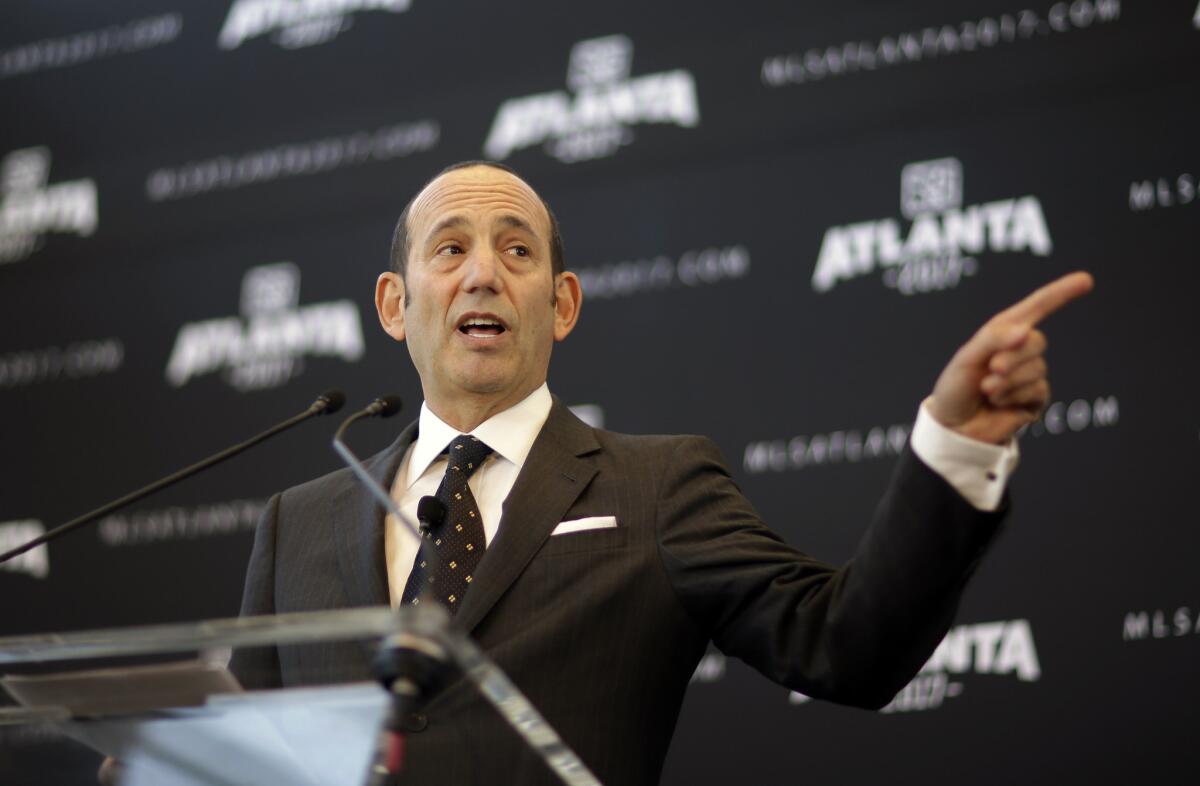Expansion could backfire on MLS

Major League Soccer Commissioner Don Garber speaks at a news conference in 2014 announcing Atlanta would be award an expansion franchise.
- Share via
No professional sports league in U.S. history has enjoyed a growth spurt like the one that has buoyed Major League Soccer over the last dozen years.
MLS has doubled in size, from 10 to 20 teams, since 2004. Average attendance has grown by nearly a third, to more than 21,300 a game, higher than the NHL and NBA. Expansion fees are more than 10 times the $10 million it cost to buy into the league in 2005 and broadcast revenues have increased 500% since then.
But rather than collect his winnings and walk away from the table, MLS Commissioner Dan Garber has decided to double down on that growth, announcing another wave of expansion that will take the league to 28 teams in perhaps as little as four years. And that’s a high-stakes gamble that could bring the whole house of cards crashing down.
See the most-read stories in Sports this hour>>
Atlanta will join the league next year. Minneapolis-St. Paul and a second Los Angeles team, LAFC, will begin play by 2018. David Beckham’s Miami franchise will enter the league at about the same time.
Expansion to Sacramento and St. Louis is likely next, followed by two cities chosen from a group of finalists that includes San Diego, Detroit, San Antonio and Austin, Texas.
Clearly Garber is betting that size matters, and with 28 teams MLS would become one of the largest first-division soccer leagues in the world. But then the commissioner, who came to soccer from the NFL, has long argued that a league that spans a continent can support more teams than a country like England, which is half the size of California.
But quality matters too and expansion could fuel a decline in the league’s already uneven level of play since eight more teams means a minimum of 224 new players. League rosters are divided 50-50 between U.S. and foreign-born players, so if that split continues, U.S. colleges and the MLS academy system would have to produce another 112 first-division-worthy players in the next four years. That seems unlikely.
Finding quality players abroad will be easier because MLS, unlike the NFL, can recruit from a global market encompassing more than 200 countries. That, however, will accelerate a decade-long transformation of MLS rosters; where once nearly seven out of every 10 players were born in the U.S., by 2020 a majority of the league’s players will be imports.
But there are other numbers at work as well. In Sacramento, the prospective ownership group is prepared to spend $110 million on expansion fees and another $226 million on a soccer-specific stadium. LAFC’s 2014 expansion fee was also $110 million and its large and deep-pocketed ownership group is about to begin construction on a $250-million stadium.
The Minnesota group is spending $250 million to get its franchise up and running. Add in what the Beckham group will spend in Miami and it comes to $1 billion in new investment over four years, significant for a league that has yet to turn a profit two decades after its first game.
So Garber is striking while the iron is hot. Soccer has never been more popular in the U.S., where 17 million people over age 6 now play the sport, according to a study by the Sports & Fitness Industry Assn. That’s more than twice as many as in Germany and England combined.
Those are the people who will soon be controlling the TV remote — and the advertising and rights-fees that follow. Continued expansion could build on that by giving MLS a larger national footprint and making it more valuable to broadcasters, who will have to renegotiate their $720-million deals with MLS after the 2022 season. So while the league has talked about adding two teams in California and two more in Texas, expect places such as Cincinnati and Detroit to get more serious consideration.
Finding the right ownership groups will be even more important than finding the right cities, though. The North American Soccer League, forerunner to MLS, expanded itself into dissolution in 1984. Moving too quickly again could set teams up to fail, derailing Garber’s master plan.
The commissioner is betting big that won’t happen. Under his plan more teams means more fans, more revenue and, eventually, more money to pour back into player development and salaries, which will eventually improve the quality of play as well.
It’s a gamble. But it’s one he believes is worth taking.
Follow Kevin Baxter on Twitter @kbaxter11







